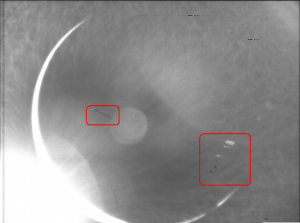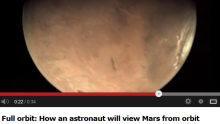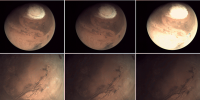FAQ developed by the VMC team at ESAC and ESOC. Please read below before contacting us, as we will regularly update responses to the most common questions here. Scroll down for general specifications and contact information; the links on the right give more technical information about the VMC and its use and history on Mars Express.
1. What is the ‘VMC’?
The Visual Monitoring Camera (VMC) is carried on Mars Express, as well as several other ESA spacecraft, including Cluster, XMM-Newton and Herschel-Planck. On Mars Express, its formal role was to image the separation of the Beagle 2 lander, a one-time event in 2003. The camera was dormant between 2003 and 2007.
The VMC consists of a small CMOS-based optical camera, which can be fitted with an on-pixel RGB colour filter for colour images. The camera has a basic command interface that can be operated by ground controllers at ESOC; it does not offer advanced features such as updateable software as found on other instruments. The VMC really is just a regular ‘webcam’ such as that found attached to any home PC, except it is specially qualified to function in the space environment.
2. Who operates the VMC?
From 2007-2018 the VMC was operated by the Mars Express Flight Control Team, based at ESOC, Darmstadt, Germany. This activity was conducted on a ‘best-effort, last-priority’ basis given the availability of planning time, command upload time and data down-link capacity.
Since 2018, the VMC has been operated by the Mars Express Science Ground Segment Team at ESAC, Madrid, Spain, and has been integrated with the planning for other Mars Express instruments. This has allowed the team to increase the variety and amount of observations possible with the VMC camera, allowing more science to be done with VMC data, as well as continuing to provide the public with amazing pictures from around Mars!
3. What format are the images we get from the VMC?

The original VMC image files contain colour information in the form of a Bayer pattern RGB filter. The colour information can be seen on every image as a grid-like overlay – the classic form of a Bayer filter.
The original VMC image files contain colour information in the form of a Bayer pattern RGB filter. The colour information can be seen on every image as a grid-like overlay – the classic form of a Bayer filter.
The camera produces a 640×480-pixel array of 8-bit intensity samples. These are received in the Mars Express Dedicated Control Room (DCR) as binary packets from the spacecraft. From these, ESOC software extracts the raw image binary files from the packets and performs a direct conversion of that data into the PNG files published on Flickr. Within each raw image are 307,200 pixels of 8 bits each (640 lines of 480 pixels). The binary file stores each pixel as an unsigned integer representing a value between 0 (black) and 255 (white). The pixels are organised with the top left pixel of the image being at the start of the binary file, then running through the image line by line from left to right of each line.
For the data found on the Planetary Science Archive as of September 2020, VMC data is available in both PNG, RAW and FITS format, where it is processed using the VMC data processing at ESAC. More information on this processing can be found in the documentation contained within the VMC datasets, in particular in the EAICD document.
4. Why are some of the VMC images so blurry or otherwise of low quality?
 Actually, they are of rather good quality – as is the camera itself – given the original intended usage.
Actually, they are of rather good quality – as is the camera itself – given the original intended usage.
The VMC was not designed to be a scientific instrument and it was designed for relatively low-resolution, fixed-focus operation. Its images should therefore not be compared to those coming from other Mars Express instruments. Further, since the camera was reactivated in 2007, at least two regions of artefacts now appear in all images (which may have been caused by debris scratching or being deposited upon the optics), and other artefacts intermittently appear.
The Mars Express VMC team are still learning which exposure settings give the best results for any particular imaging series; illumination conditions and pointing vary dynamically from one orbit to the next.
5. Why do the last few image sets posted look the same?
They do look similar, but certainly not the same! This is to do with the orbit of Mars around the Sun and the evolution of the Mars Express orbit around Mars. The angles between the Sun, Mars and the spacecraft therefore vary gradually over the whole Martian year (two Earth years).
This means that for a period of days or weeks the lighting on Mars and the phase (like we see phases of the Moon from Earth) stays quite similar, so the images looks similar. If you look closer at the surface or at the pattern of clouds above it, you’ll see that each image is a unique view of Mars. If you look back through the archive you’ll see the broader change in the images evolving over weeks and months.
6. Where was Mars Express when each image was taken?
Most VMC images are captured close to apocentre – the furthest point from Mars in Mars Express’ elliptical orbit – at around 10,000 km from Mars (this is due to a constraint preventing operation with other Mars Express instruments). However, you may also see observations of the limb of Mars, as well as pictures taken closer to the pericentre – the closest Mars Express gets to Mars in its orbit.
7. How often are images taken?
The images are taken in batches, called observations. The amount of images in an observation varies depending on the available time for VMC activities. VMC images are captured at just under one per minute.
These observations take place as often as possible, but this can vary widely. Sometimes we’ll get image sets daily, and other times there may be only one new set in a month. Although VMC is now an official science instrument, VMC observations are still lowest priority compared to the other instruments on Mars Express, and may sometimes be delayed due to higher priority activities. Check the site often!
8. How long after an image is taken does it get posted?
This depends a lot on how much spare time the spacecraft has after sending all the primary Mars Express science data to Earth. After VMC pictures are taken they are stored in memory on the spacecraft and wait there to be sent back to Earth at the earliest free opportunity. The time waiting on board can vary from less than an hour to more than a week.
Once the images get a free slot the spacecraft sends them to Earth on a journey that takes the data between 4 and 22 minutes (depending on the position of Earth and Mars). They then arrive at a ground station and are sent to the spacecraft control centre, ESOC, where an automated tool picks up the images and posts them to the Flickr blog, as well as sending this data to ESAC where it can be processed for scientific purposes.
Questions?
Post a question to use below – we’ll get back to you as soon as possible.
VMC specifications
Lens
Focal length: 12.3 mm
Focal ratio (F/#): 5
FOV: 41.38º x 31.04º.
Instantaneous FOV: 0.00112859 rads/pixel
Wavelength range: 400 – 650 nm
Detector: 640×480 pixel CMOS
Pixel pitch: 14 µm pixel pitch
Sensor
Sensor Type: IMEC IRIS-1 integrating CMOS APS
Colour: Bayer pattern RGB filter on chip
Image size: 640×480 pixels
Shutter: Electronic
Sensor size: 10×8 mm
Pixel depth: 8 bits
Individual pixel size: 14 µm
Spectral response: 400-900 nm
Signal-to-Noise ratio: 65 dB
Image acquisition duration: 200 ms + exposure time
Unit
Size: 65x60x108 mm
Mass: 430 g
Operating temperature: -50 degrees to +65 degrees
VMC internal image buffer capacity: 1 full VMC image
Image transfer duration (to Mars Express mass memory): 38s
Power input: 28 V
Power consumption: 2.8 W average, 5 W peak
Interface to spacecraft: serial



